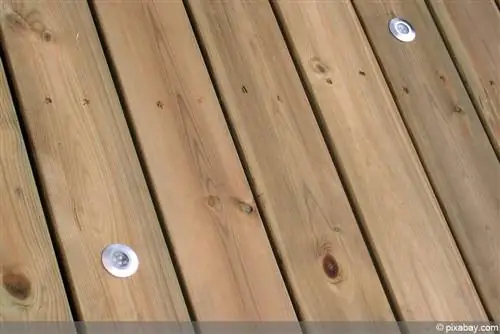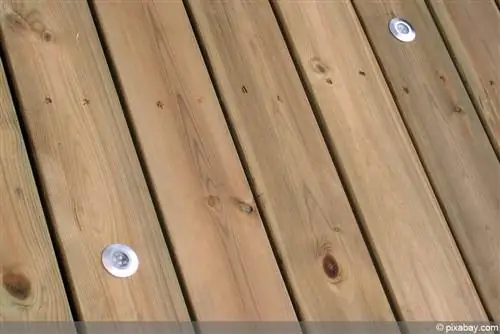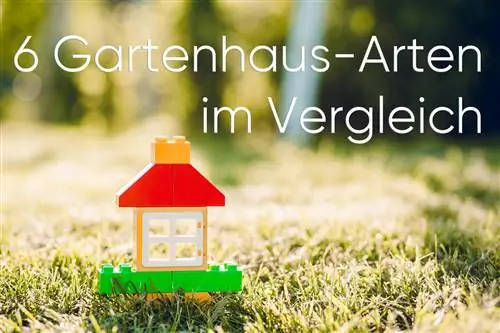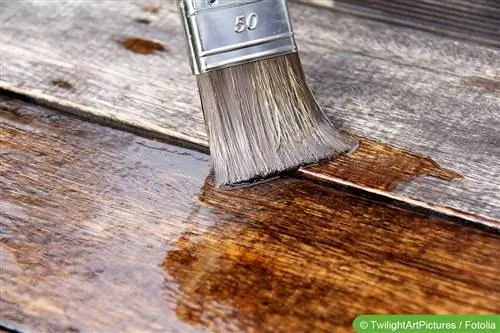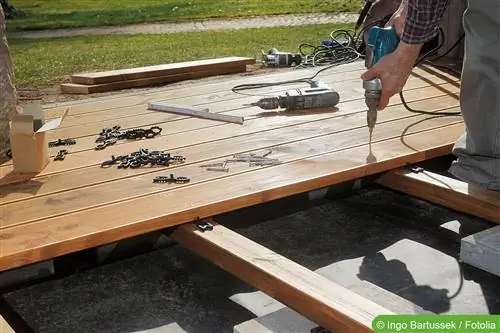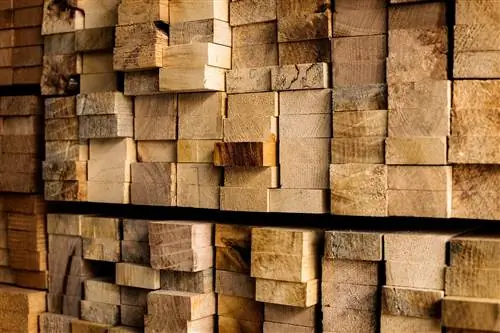- Author admin [email protected].
- Public 2023-12-17 03:39.
- Last modified 2025-06-01 06:48.
Tropical wood species are extremely popular as patio wood. Because they are very hard and have a high resistance to wood-destroying fungi. But is it really necessary to use patio wood from the other side of the world or can local wood also score points? Our comparison shows the advantages and disadvantages of the types of wood and reveals what you need to pay attention to when choosing terrace wood.
Selection criteria
Choosing patio wood based solely on its appearance or purchase price is of course tempting. After all, many people already have a precise image of the new veranda in their mind's eye and also a fixed budget.
Before buying, however, other factors should also be taken into account so that there are no unpleasant surprises when it comes to processing, care and durability. These crucial points include:
- Abrasion resistance
- Durability
- Hardness
- Costs
- Optics
- Ease of care
- Weatherproofing
In addition, four quality characteristics should be taken into account when selecting and comparing the type of wood. These are:
- Durability: Wood-destroying fungi can cause a lot of damage. Therefore, the terrace wood should have resistance class 1 or 2.
- Origin: The statement FSC-100% stands for safe origin and sustainable cultivation
- Wood quality: FAS stands for “First and Seconds”, i.e. first and second choice wood and therefore the highest quality. The term Premium is also common in Germany.
- Drying: Drying the wood prevents the planks from warping and bending later. Wood that has been technically dried or is labeled KD (kiln dried) is ideal.
Tropical Patio Wood

Tropical woods are very popular. Due to their origin, they have a high level of resistance to wood-destroying fungi and insect infestation and for this reason, among other things, they are very durable. They are also well weatherproof and abrasion-resistant. So it's no wonder that the following tropical wood species are often used in terrace construction:
- Bangkirai
- Bilinga
- Cumaru
- Garapa
- Ipé
- Keruing
- Massaranduba
- Teak
However, these types of wood do not only have advantages. Since tropical wood species are very hard, they are difficult to work with. Special, hardened tools are sometimes required for this. In addition, a lot of time, effort and energy. Even then, it is not always possible for laypeople to clean the decking boards. Bleeding also needs to be taken into account. This leads to unsightly, dark discoloration - which can also arise from contact with iron.
In addition, tropical wood has to travel long distances. This means that transport is not exactly environmentally friendly. Not to mention deforestation, which has a serious impact on the habitat of animal species that are sometimes threatened with extinction. If you still want tropical wood for the terrace, you should check its origin. The FSC-100% seal ensures that the wood is from a sustainable and socially responsible economy.
In comparison, tropical types of wood are expensive to purchase. However, with appropriate care, they are also very durable. So you have to weigh up whether the costs of purchasing and professional treatment should be borne or the veranda should be renewed more frequently.
Local patio wood
Terrace wood from local forestry is usually significantly cheaper than tropical wood. On the one hand, this is due to the shorter and therefore more environmentally friendly transport routes. However, they also have a significantly lower hardness and durability. For example, Douglas fir only lasts half as long as tropical wood species. This is neither an estimate nor an advantage, the shorter service life is actually proven by DIN standards.
Nevertheless, local types of wood also have advantages to offer. Suitable for terrace construction include:
- Douglas fir
- Oakwood
- Larch
- Robinie
- Thermal Ash
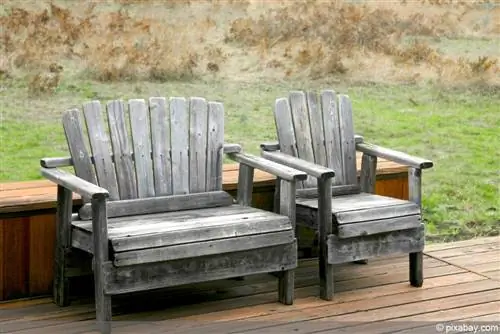
These do not bleed, but release the highest resin. With high-quality and appropriately processed variants, even this is not a problem. They are also significantly cheaper. Even the lower hardness does not have to be a pure disadvantage. Because it means that the wood is easier to work with. Especially if you want to build the terrace yourself, it is better to use local wood. In addition, in many cases it is not necessary for the terrace wood to be as hard as the types from the tropics. With normal use and a location that is not consistently damp, cool and dark, the local woods can keep up without any problems.
WPC planks for the terrace
WPC floorboards are a combination of wood and plastic that combines the advantages of both materials. They are made from wood flour and special so-called polymers. The wood content is usually between 30 and 50 percent. The higher the proportion of wood, the more natural the floorboards appear. However, the wood content says little about durability.
Therefore, the decision here can be made in favor of cheaper types of wood or variants with a lower natural content. The advantage is that WPC boards are more resistant to moisture, fungi and insects. However, the price is slightly higher due to the manufacturing process - but the planks are still cheaper than treated local wood and tropical wood.
Types of wood in comparison
For individual comparison, the most important types of wood for terrace construction have been compiled here, including their properties, advantages and disadvantages.
Bangkirai
Bangkirai - also spelled Bankirai - is very tough and resilient and was trendy for a while. Unfortunately, that's exactly what became a disadvantage. The great demand ensured that some of the wood was sold without being dried or seasoned. The result was bent and warped floorboards and massive deforestation of the corresponding forests. This problem can be avoided by taking the origin and drying into account. The problems with the Bangkirai are still:
- Discoloration from brown to gray to black, due to light, time and contact with ferrous metals
- Holes caused by insects
- Hardly uniform quality, as different woods belong to the Bangkirai group
- Hardly any grain, therefore visually unappealing
Bilinga
Resilient, resistant to fungi and insects - Bilinga is not exactly cheap, but it is durable and easy to care for. However, over time it becomes dark and gradually grays. Even regular treatment with terrace oil can only delay this development but cannot completely prevent it. In addition, constructive wood protection should be applied.
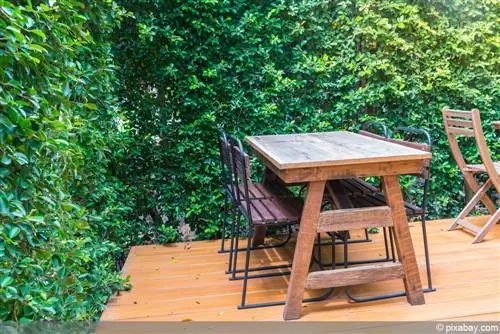
Cumaru
Cumaru is also known as Brazilian teak but is rarely found in Europe. However, it is beginning to become increasingly popular because it has the highest resilience outdoors and is particularly hard. Care is only required - and possible - in the form of terrace oil. Because the Cumaru wood hardly absorbs other substances.
However, two clear disadvantages are that it is difficult or even impossible to build the terrace yourself. The wood is so hard that it is difficult to work with. In order not to cause any damage, professionals should carry out the installation. In addition, sustainably grown Cumaru is only available in very small quantities in Europe and is therefore correspondingly expensive.
Garapa
Garapa is sluggish - so it takes a long time to dry, but it is also well suited to damp areas and hardly bends or warps. Machining is still relatively easy with the appropriate carbide tools. For clean results, professional processing and assembly should also be carried out here.
Ipé
Ipé is relatively unknown in this country but very high quality. What sets Ipé wood apart is its resistance to insects. However, this also makes it very expensive.
Douglas fir
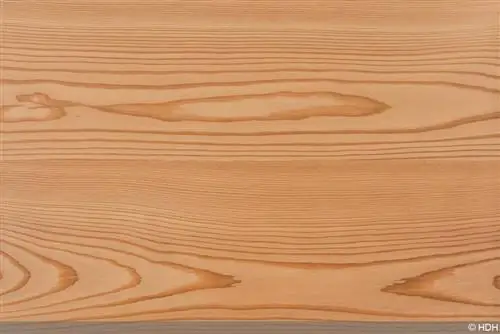
Douglas fir is inexpensive and easy to process. It is therefore ideal for building your own terrace. However, the local wood is not particularly durable and, as mentioned, only lasts half as long as tropical wood. It dries quickly, but should be stored for a long time to prevent resin from escaping.
The partly golden brown color and attractive grain are visually appealing. However, the low price is convincing.
Robinie
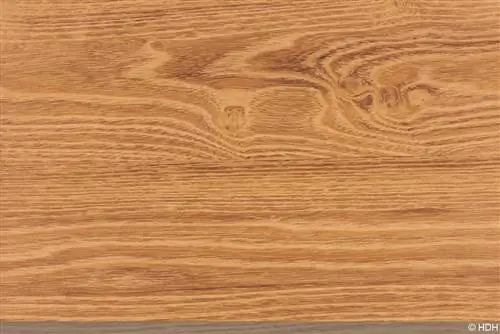
In terms of resilience, robinia can (almost) keep up with tropical woods. Fungi and insects also have little chance with this type of wood. However, the processing is just as demanding as with Cumaru and Co. The price, however, is lower.
Thermal Ash
Hard, resistant, resilient and long-lasting - thermal ash is also a wonderful alternative to tropical wood species for the terrace. The wood does need to be specially treated and is therefore usually a little more expensive - but the investment makes ecological sense and pays off in the long term.
Image source: HDH (Main Association of the German Wood Industry)

